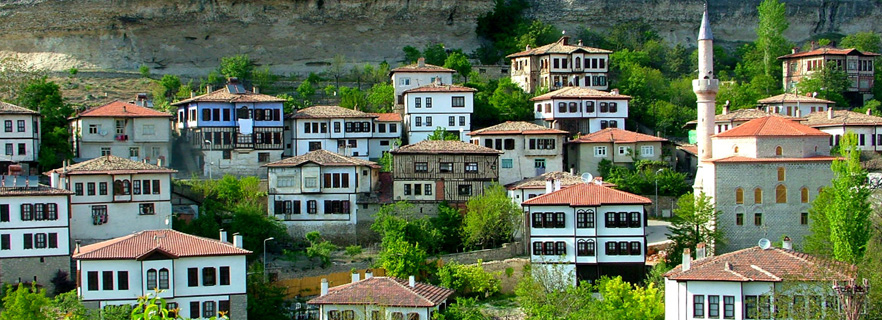 Safranbolu
Safranbolu
Safranbolu is an exemplary city that presents the historical and cultural works to all people, keeping the characteristics of the traditional Turkish society life on the city scale. The rich cultural heritage it possesses and its success in preserving this heritage has made Safranbolu one of the world's most famous cities and has been granted UNESCO's World Heritage List.
Safranbolu, better known for its Old Turkish Houses, is attracting more and more attention with its historical dimensions, its natural beauties and its role as an example in protecting the city scale. Safranbolu, with its 1200 cultural protected artifacts, is today the most well-preserved place on the city scale.
History
The known history of Safranbolu, located in the area called Paphlagonia in the northwestern part of Anatolia, It dates back to 3000. Safranbolu, which takes its name from a saffron plant that can paint a hundred thousand times as much liquid yellow as its weight, has been home to many civilizations throughout history. The main ones are Roman, Byzantine, Seljuk and Ottoman Empires. It is known that Safranbolu was taken strictly by the Turks in 1196.
Safranbolu reached its highest economic and cultural level in the past, during the Ottoman period. In the 17th century the city became an important accommodation center on the Istanbul-Sinop caravan road and enriched the region rapidly by enabling the development of trade in the region. During this period, he had intense relations with Istanbul and Kastamonu, some of the Ottoman Palace and the statesmen left important works in the city.
Climate
The climate in Safranbolu shows the transition between the Black Sea climate and the Central Anatolia climate. The summers are warm, the winters are cold, the spring is warm and cool. Spring and autumn are quite relaxed.
Places to visit
Safranbolu, better known for its Old Turkish Houses, has countless cultural heritage protected by 1200.
The houses are gathered in two parts of the city. These are the Bazaars where the winter houses are located, and the Vineyards where the other summer houses are located.
The area that the city's tourist and historical monuments intensify is the Çarşı section. This area can be seen from the Kale in the north and the Hıdırlık hills in the south. Hıdırlık Tepesi, which has two monumental graves on it, was used as an open-air prayer place in ancient times. From this hill it is possible to see monumental works of the city together.
The castle and its surroundings are the first settlements. The Old Government Building on this hill is the 200-year-old Clock Tower still in operation and the Prison House, which is no longer used, of the city's worthy historical monuments.
There are over 25 mosques in the city with historical significance. The most important ones are Köprülü Mehmet Paşa and Sultan III. Selim's grand vizier, Izzet Mehmet Pashan, is made of glass with his own name.
Cinci Han opened to the service and the Cinci Bath which is still being used has been built by the Safranbolu Cinci Hodja, which has risen to the consultancy of Sultan Deli Ibrahim, and the city is worth seeing.
Production and trade in Safranbolu was carried out in various bazaars carried out with the Guild system. The Bronze, Bakrcilar, Kalaycılar and Semerciler Çarşıları, still in production today, provide the continuation of the handcraft in the city. After the restoration, the historical Yemeniciler Arastasi, which became a handicrafts sales center, and the shops around it sell safranbolu souvenirs.
Yoruk Village
On Safranbolu-Araç road, Safranbolu is 13 km to Kent. Yoruk Village in the distance is an open air museum. Transportation by taxi is possible.
The houses and streets under protection are all well-maintained. Kaymakçıoğlu Mansion, Sipahiler Mansion, Wooden Mosque and art gallery are restored as the laundry can be visited. Pancakes and baklava in the village are edible, various souvenirs can be bought. Accommodation is not available.
Natural beauties
Safranbolu has interesting natural attractions as well as historical monuments and houses. The intensive forest areas, canyons and valleys also allow other tourist attractions such as hiking, climbing and cycling as well as picnicking.
Incekaya Aqueduct and canyon, Yörük Village with its splendid houses, Bulak and Cicada Caves, Hacilarobasi and Kaya Tombs around Üçbölük Village, Düzce Canyon, Sarıçiçek Plateau and Uluyayla, Gürleyik Picnic Area are other tourism areas of the city.

 Safranbolu
Safranbolu